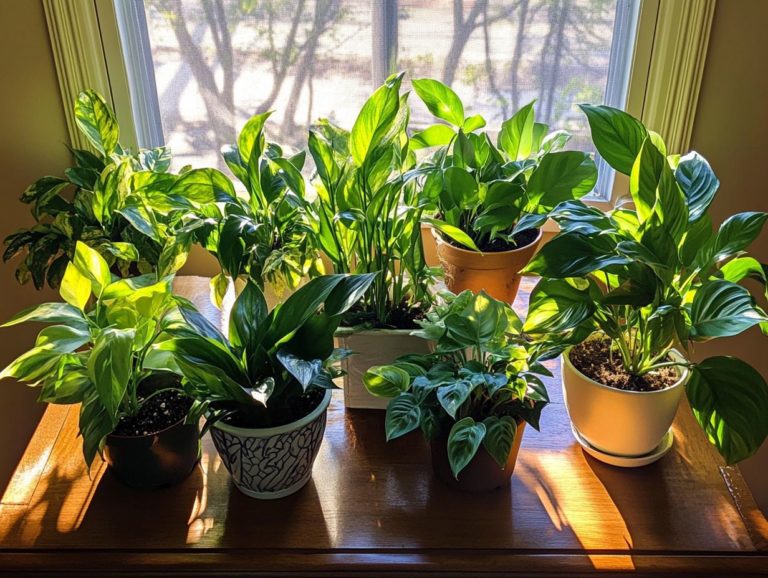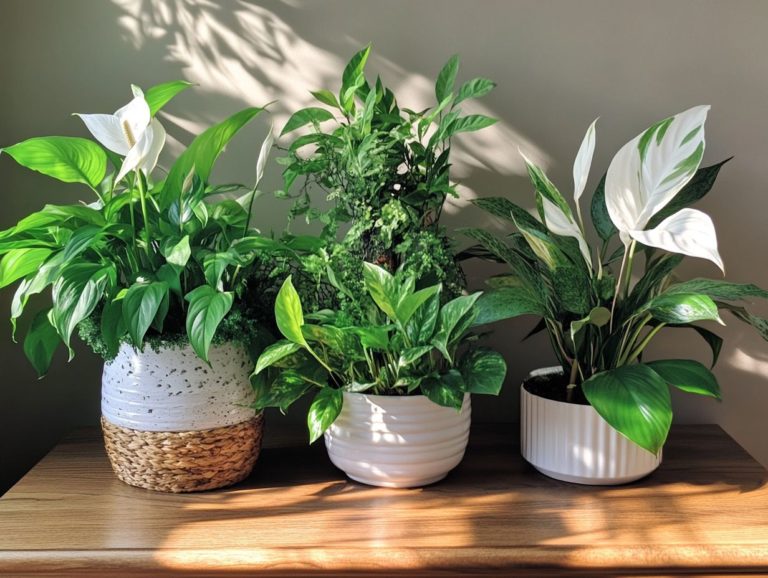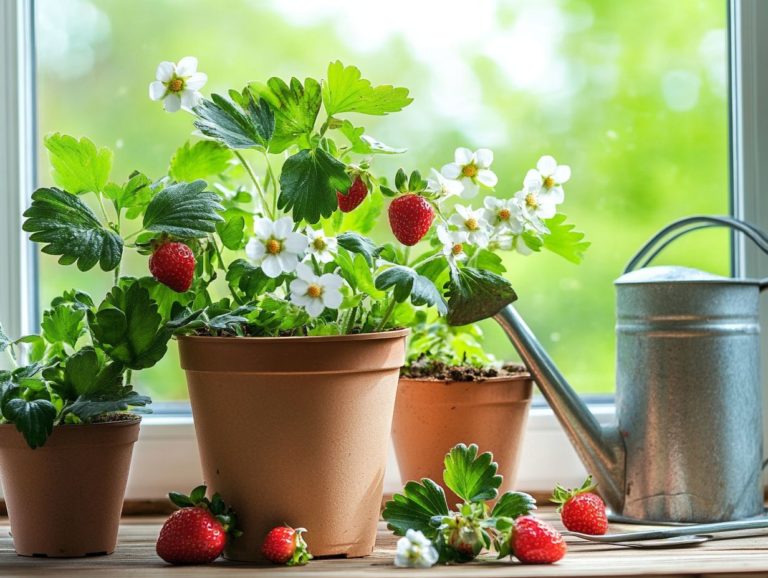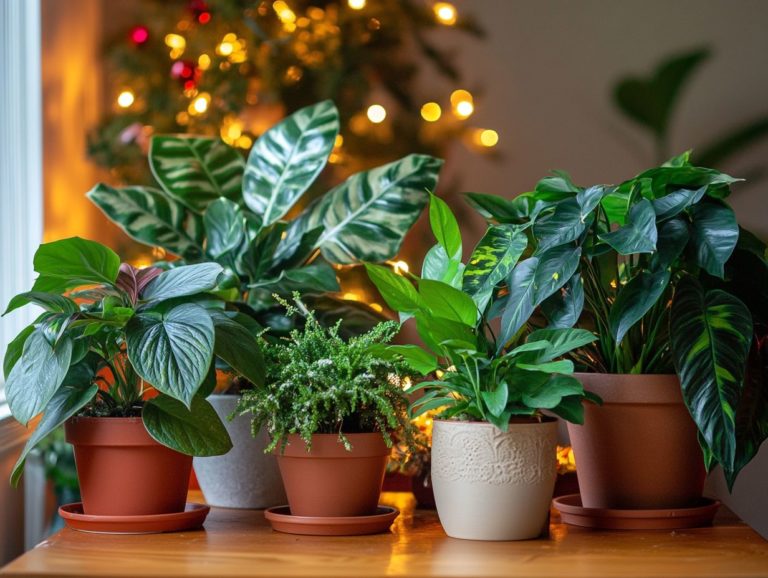How to Choose Hardy Indoor Plants
Indoor plants offer incredible benefits that can transform your space! They can elevate both air quality and your mood.
Whether you re an experienced plant enthusiast or just starting your indoor gardening journey, selecting the right plants can feel both exciting and daunting. This guide will walk you through the many benefits of indoor greenery and crucial factors to consider when choosing the ideal plants for your home.
You ll also find valuable tips for keeping your plants healthy and vibrant. From low-maintenance options to resilient varieties suited for specific environments, you ll learn how to cultivate a flourishing indoor oasis.
Contents
- Key Takeaways:
- The Benefits of Indoor Plants
- Factors to Consider When Choosing Indoor Plants
- Low Maintenance Indoor Plants
- Hardy Indoor Plants for Specific Environments
- Tips for Keeping Indoor Plants Healthy
- Frequently Asked Questions
- What should I consider when choosing hardy indoor plants?
- What are some hardy indoor plants that do well in low light?
- How can I tell if a plant will thrive in my home s light?
- How do I choose a hardy indoor plant that requires minimal maintenance?
- Are all hardy indoor plants safe for pets?
- Can I mix different types of hardy indoor plants in one pot?
Key Takeaways:
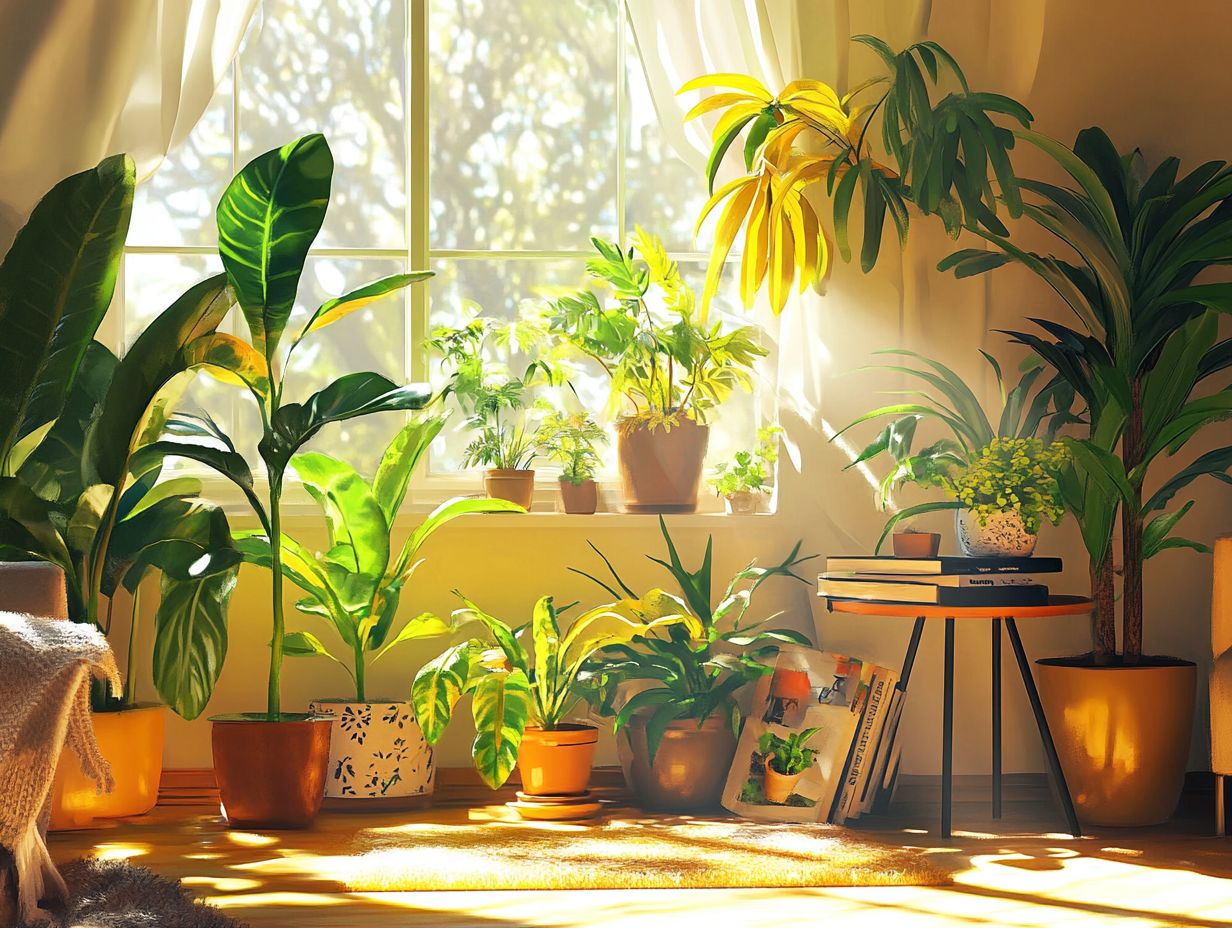
- Indoor plants improve air quality and mood, making them a great addition to any home or office space.
- Consider lighting, temperature, and space when choosing indoor plants.
- Options exist for low maintenance and hardy indoor plants suited for all environments.
The Benefits of Indoor Plants
Indoor plants present a wealth of benefits, enhancing the aesthetic charm of your space while significantly improving air quality and mood.
Houseplants like the parlor palm, peace lily, and fiddle leaf fig act as plants that clean the air by absorbing toxins and releasing oxygen, fostering a healthier indoor environment.
Tropical plants create a soothing atmosphere, making any room feel more inviting and vibrant.
Improved Air Quality and Mood
Indoor plants are more than just decor; they significantly enhance air quality and uplift your mood. Certain varieties, such as aloe vera, peace lily, and spider plant, play a crucial role in purifying the air through their natural processes.
Research indicates that these plants can effectively remove harmful chemicals like formaldehyde and benzene, improving the overall ambiance of your indoor environment.
A study conducted by NASA reveals that peace lilies are not only aesthetically pleasing but also highly efficient at purifying the air.
Incorporating greenery into your living space has been linked to lower stress levels and enhanced mental well-being. Nurturing these plants can contribute to a healthier lifestyle and a tranquil atmosphere.
Factors to Consider When Choosing Indoor Plants
When selecting indoor plants, you should pay attention to several crucial factors, such as lighting conditions, temperature preferences, and humidity levels, along with the size of your available space.
Understanding these elements is essential to ensure that your chosen houseplants whether it’s a vibrant fiddle leaf fig or a resilient snake plant thrive beautifully in their new home.
Lighting and Temperature Requirements
Understanding the lighting and temperature requirements of your indoor plants is essential for their growth and longevity, as different species have unique needs.
If you have a fiddle leaf fig, it will thrive in bright, indirect light, allowing its impressive large leaves to flourish. A peace lily enjoys similar conditions that protect it from sunburn while soaking up ample brightness.
If low light is a challenge in your space, consider the ZZ plant or cast iron plant, which excel in darker corners, showcasing their remarkable resilience and adaptability.
Tropical plants typically prefer temperatures between 65 F and 80 F to truly thrive. Fluctuations outside this range can lead to stress and stunt their growth. By familiarizing yourself with these preferences, you ensure your plants remain vibrant and streamline their overall care routine.
Start selecting your indoor plants today to enjoy a fresh, vibrant home!
Size and Space Considerations
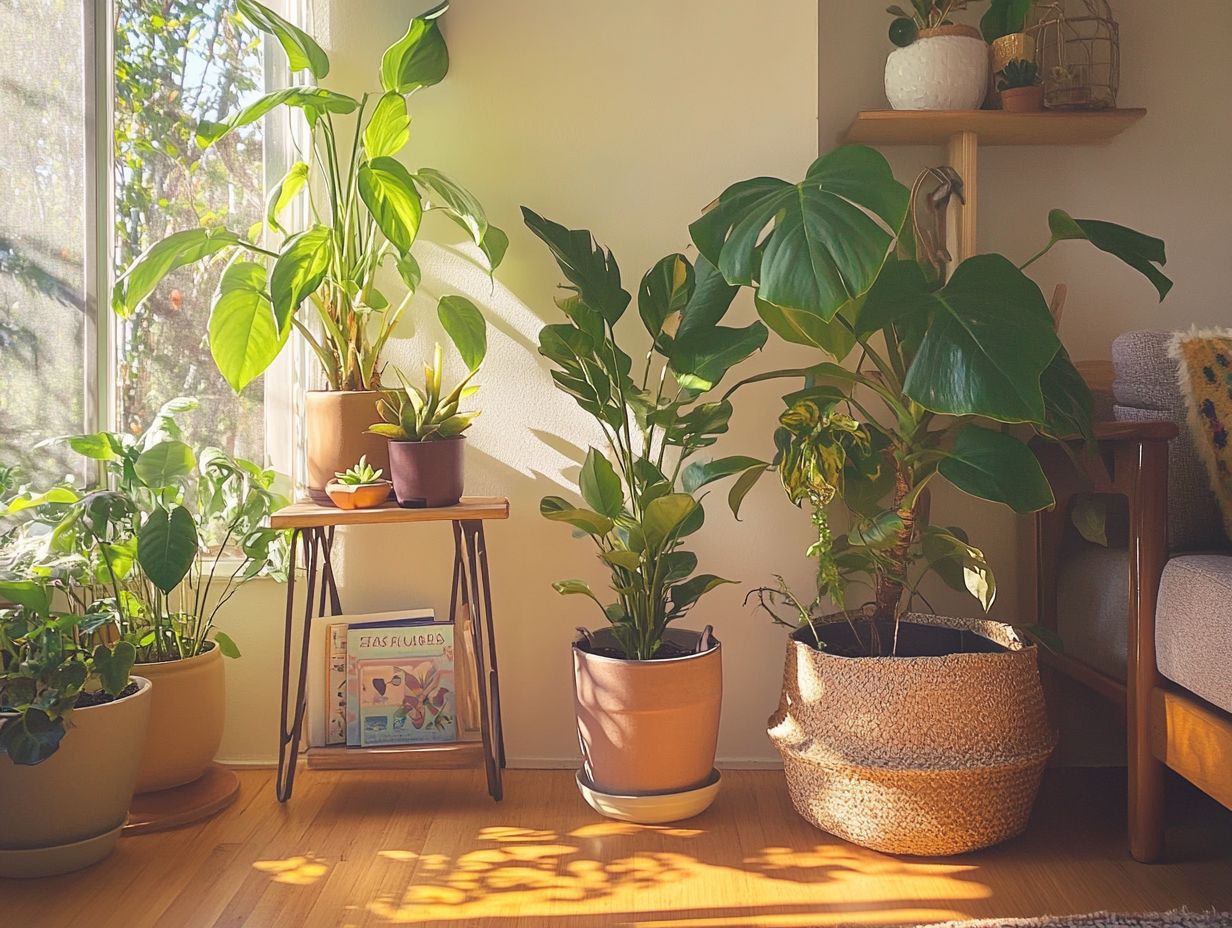
Considering the size and space available is essential when selecting indoor plants. This choice impacts both the look and the health of your greenery.
Larger varieties, like the towering rubber tree, can make a bold statement in your room. However, they demand ample vertical space and can easily overwhelm smaller areas.
On the flip side, smaller plants such as the jade plant are ideal for tight spots. They allow you to effectively showcase them on windowsills or shelves.
Striking the right balance between tall and short plants can elevate the visual interest in your space. Pairing a rubber tree with trailing vines or compact succulents creates a delightful layered effect.
It s vital to ensure that each plant receives adequate light and air circulation. This promotes their well-being while maximizing their beauty in your home.
Low Maintenance Indoor Plants
If you re yearning for a touch of greenery without the burden of constant care, low-maintenance indoor plants are the perfect solution. They effortlessly combine beauty with minimal effort.
Consider options like the snake plant and ZZ plant; they thrive in various conditions and need only occasional watering. They fit perfectly into busy lifestyles or for those just starting their journey into plant ownership.
Easy to Care for Options
Some of the simplest indoor plants to care for include the snake plant, ZZ plant, and peace lily. Each of these beauties requires minimal attention while still enhancing your space s look.
These sturdy plants thrive in many indoor spaces, making them perfect for both newcomers and seasoned plant lovers.
- The snake plant thrives in indirect light and needs watering only when the soil has completely dried out.
- The ZZ plant is known for its hardiness, flourishing even in low light and requiring infrequent watering to keep its rich, waxy leaves looking their best.
- The peace lily not only graces your space with elegant white blooms but also tolerates lower light levels, needing hydration just once a week.
For all these plants, keep them in well-draining pots to avoid root rot. A periodic dusting of their leaves enhances their ability to photosynthesize, which is how plants make food from sunlight. For more options, check out low light indoor plants: top choices. Regularly check moisture levels, but rest assured, these plants forgive occasional lapses in care, making them ideal companions for your home.
Hardy Indoor Plants for Specific Environments
Certain resilient indoor plants are perfectly tailored for challenging environments, whether it s low light conditions or high humidity. This means that even in less-than-ideal settings, you can cultivate a lush, vibrant greenery that thrives effortlessly.
Plants for Low Light Environments
For indoor spaces that lack ample sunlight, you ll find that several plants thrive beautifully in low light, including the parlor palm, snake plant, and ZZ plant. These resilient species not only bring a refreshing touch of greenery but also elevate the ambiance of dimly lit rooms.
The parlor palm flourishes in indirect light and requires minimal watering, making it an excellent choice for your busy lifestyle. The snake plant impresses with its striking upright leaves, adapting effortlessly to various light conditions while needing little water and providing air-purifying benefits. For optimal growth, it’s crucial to understand how to choose soil for her indoor garden.
Then there s the ZZ plant, boasting its glossy, oval leaves that can endure neglect. It thrives even in the shadiest corners of your home. To keep these green companions healthy, avoid overwatering and provide occasional fertilization during the growing season.
Enhance their enduring beauty and enjoy a vibrant, low-light environment!
Plants for High Humidity Environments
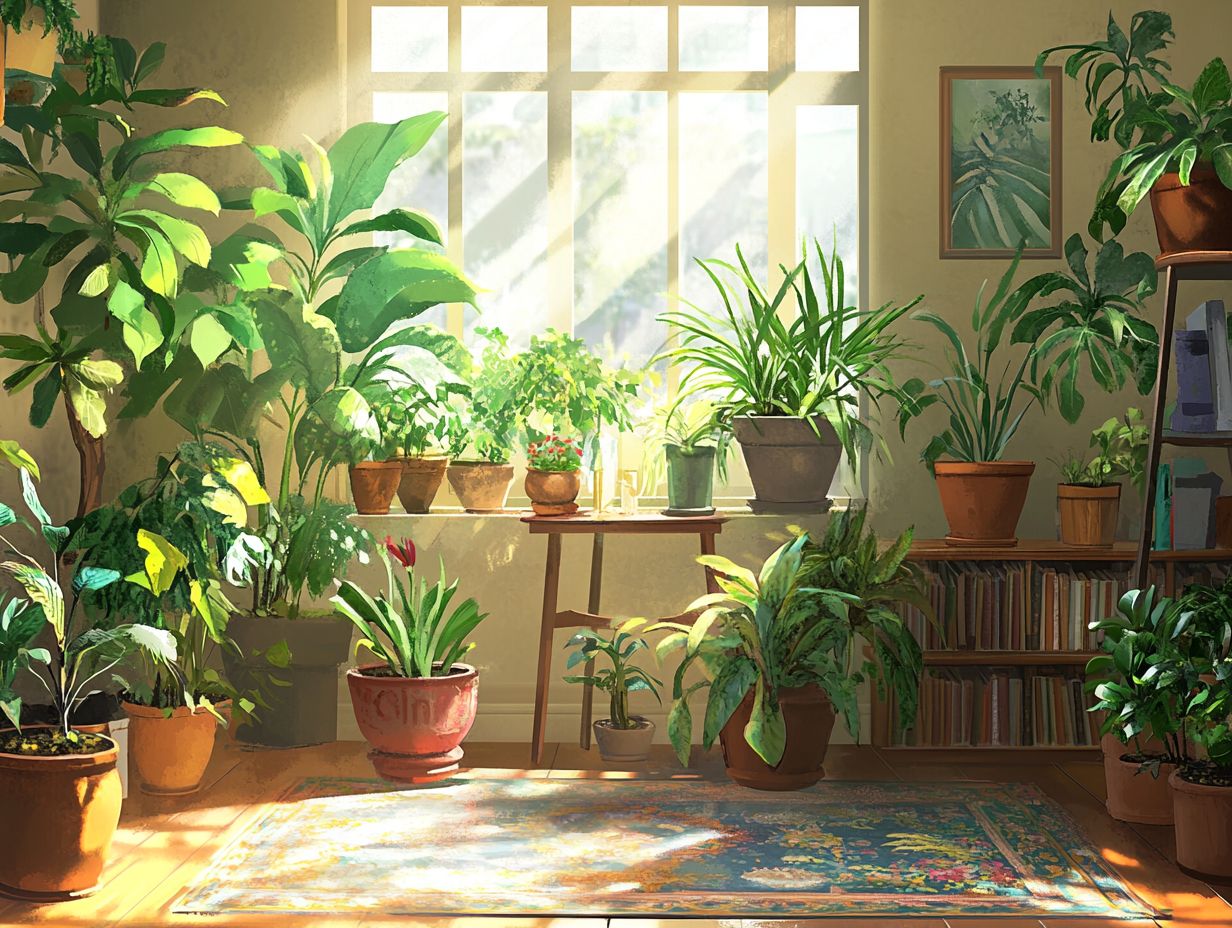
High humidity environments are a paradise for tropical plants like the peace lily and Bromeliad. These plants thrive in these conditions and bring a lush vibrancy to any space.
These lively plants flourish in moist air, making them ideal for bathrooms, kitchens, or sunrooms where humidity levels are higher. If you’re looking to create your own tropical oasis, consider incorporating varieties such as ferns, philodendrons, and orchids. To ensure their health, you should also learn how to find the right soil for your indoor plants. Each adds its own unique textures and hues, enhancing the overall aesthetic.
To promote healthier growth, regular misting, maintaining consistently moist soil, and occasional fertilization are essential. Just be sure to keep an eye out for signs of overwatering, as these tropical beauties also appreciate good drainage.
Choose the right plants and give them the care they need. You ll create a vibrant and lush indoor garden that feels like a tropical retreat!
Tips for Keeping Indoor Plants Healthy
To ensure the vitality of your indoor plants, you must adopt a considerate approach. This involves establishing a consistent watering routine, employing effective fertilization methods, and implementing proactive pest prevention.
Watering and Fertilization Techniques
Establishing a proper watering schedule and mastering fertilization methods are crucial for the health of your indoor plants. This ensures they receive the nutrients they need without the risk of overwatering.
To see your plants thrive, pay close attention to their unique needs! Each species has its preferences for moisture levels and nutrient uptake.
Take jade plants, for example; these succulents appreciate less frequent watering. In contrast, tropical varieties like the rubber tree relish more consistent moisture. By honing your ability to recognize signs of distress such as wilting leaves that signal underwatering or yellowing leaves that point to overwatering you can effectively tailor your care regimen.
Strategically applying fertilizers during the growing season can significantly boost your plants vitality. A diluted liquid fertilizer works wonders for jade plants, while a balanced formulation supports the robust growth of rubber trees. Ultimately, success lies in finding the right balance and remaining attentive to your delightful indoor green companions.
Pest Prevention and Control
Effective pest prevention and control methods are crucial for maintaining the health of your indoor plants, protecting them from common nuisances like spider mites and aphids.
To navigate this challenge successfully, implement a variety of strategies that go beyond mere chemical solutions. Embrace environmental controls and natural remedies as well.
Regularly inspecting your plants for signs of distress allows you to catch infestations early, enabling swift action. Encouraging beneficial insects such as ladybugs can help keep harmful pest populations in check.
Certain plants like basil and marigold act as natural deterrents thanks to their pest-repelling properties. By integrating these tactics, you can cultivate a thriving, pest-resistant environment that showcases your indoor gardening expertise.
Frequently Asked Questions
What should I consider when choosing hardy indoor plants?
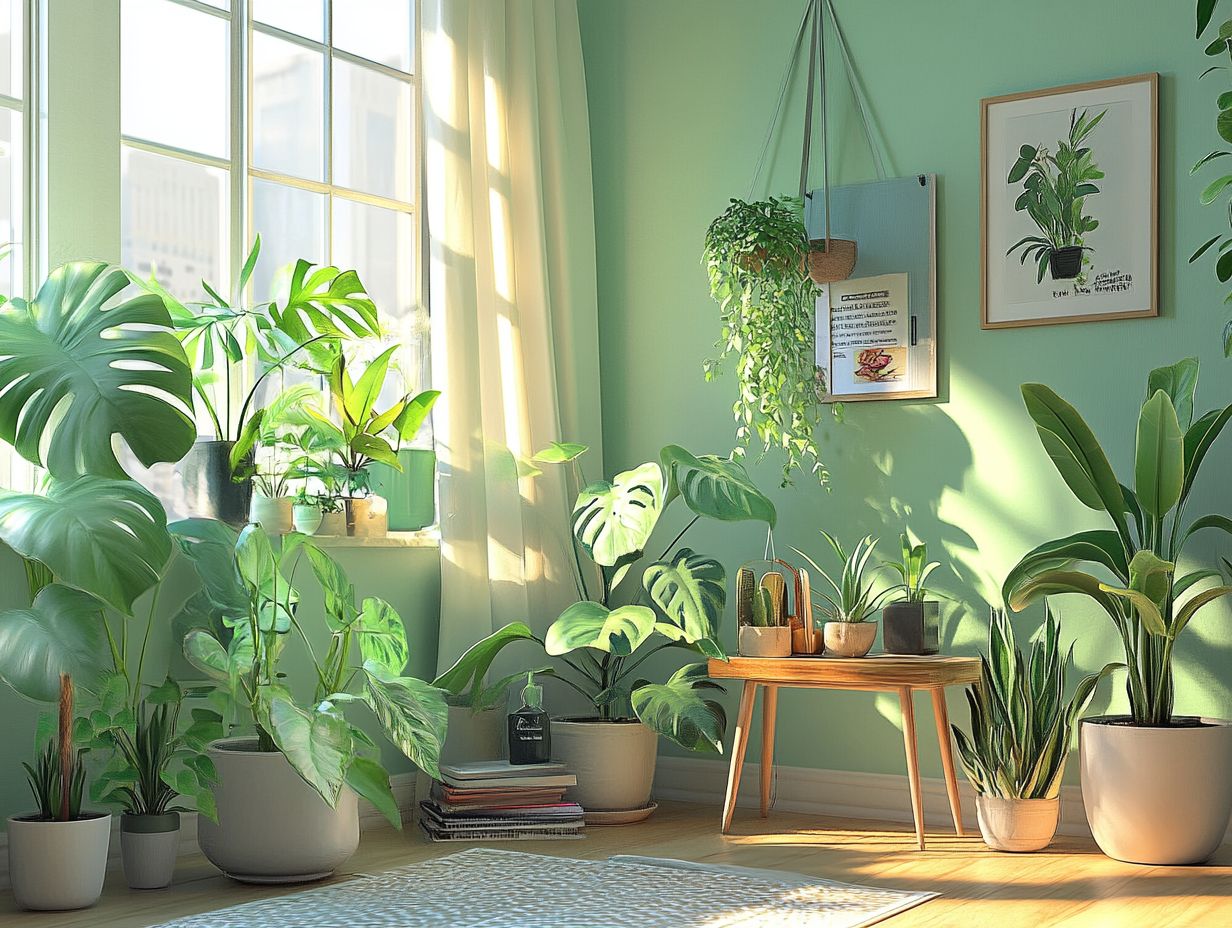
When choosing hardy indoor plants, it is important to consider the lighting conditions in your home, the level of maintenance you can provide, and the specific needs of the plant in terms of water and humidity.
What are some hardy indoor plants that do well in low light?
- Pothos
- Snake plant
- Peace lily
- Chinese evergreen
How can I tell if a plant will thrive in my home s light?
You can determine a plant’s lighting needs by checking the care instructions or asking a knowledgeable staff member at the store where you are purchasing the plant.
How do I choose a hardy indoor plant that requires minimal maintenance?
Choose plants that are tough and can thrive in various conditions. Great options include succulents, spider plants, and ZZ plants.
Are all hardy indoor plants safe for pets?
No, some hardy indoor plants can be harmful to pets. For example, lilies and philodendrons can be toxic to cats and dogs, so always check a plant’s safety before bringing it home.
Can I mix different types of hardy indoor plants in one pot?
Combining different hardy indoor plants in a single pot can make your space more lively. Just ensure they have the same light and watering needs to help them thrive together.

